3D Printing Technology Assignment PDF
VerifiedAdded on 2021/06/14
|16
|4411
|81
AI Summary
Contribute Materials
Your contribution can guide someone’s learning journey. Share your
documents today.
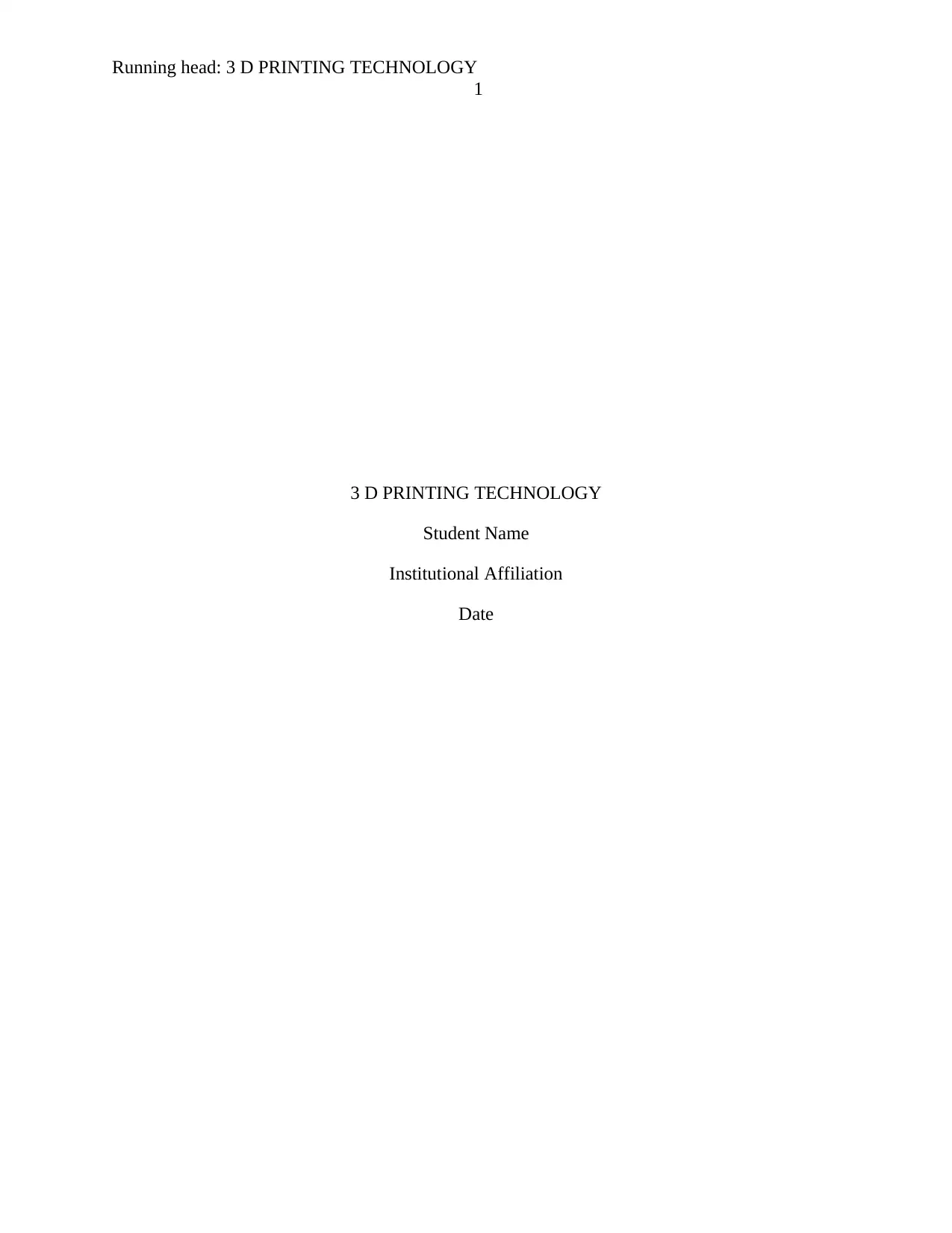
Running head: 3 D PRINTING TECHNOLOGY
1
3 D PRINTING TECHNOLOGY
Student Name
Institutional Affiliation
Date
1
3 D PRINTING TECHNOLOGY
Student Name
Institutional Affiliation
Date
Secure Best Marks with AI Grader
Need help grading? Try our AI Grader for instant feedback on your assignments.
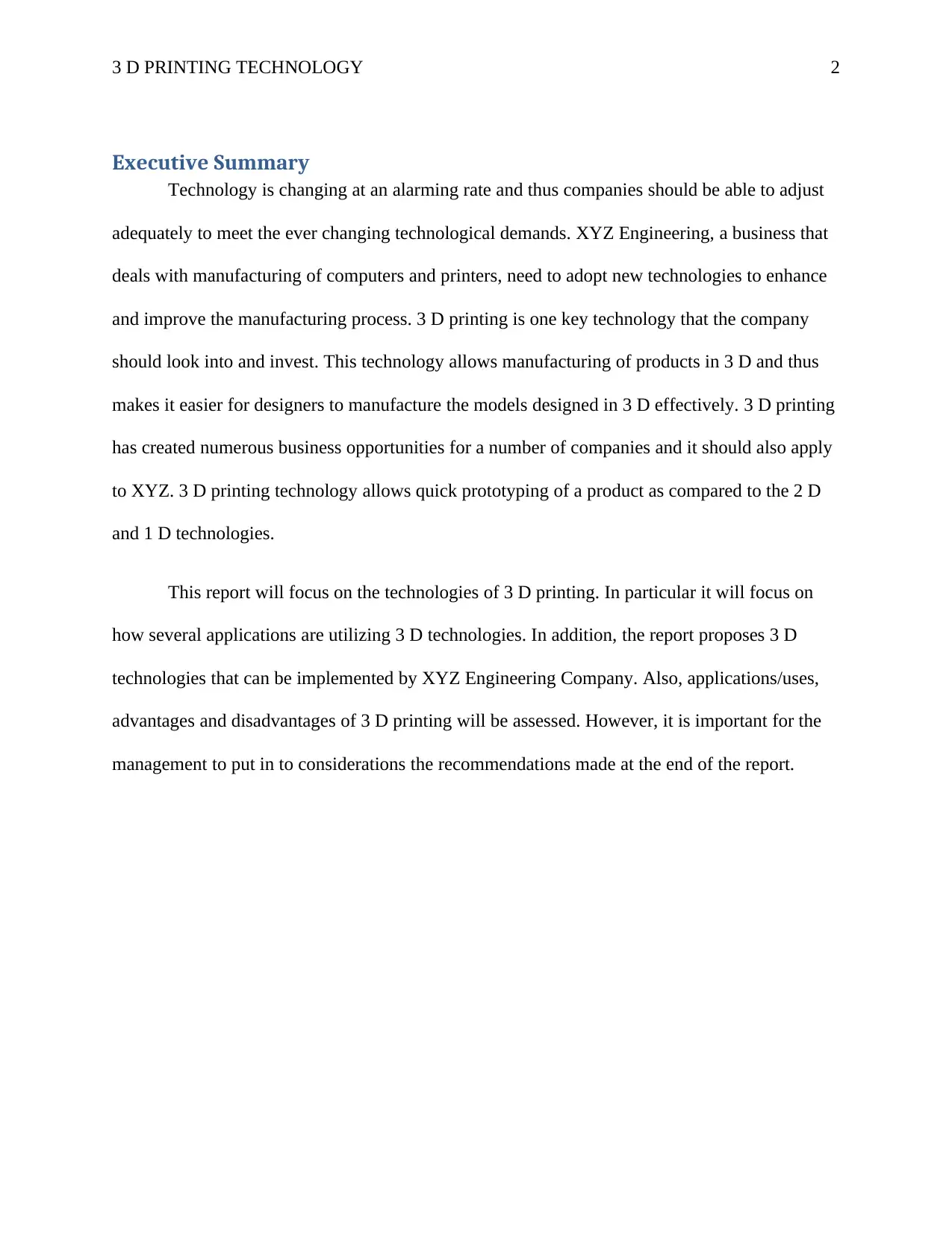
3 D PRINTING TECHNOLOGY 2
Executive Summary
Technology is changing at an alarming rate and thus companies should be able to adjust
adequately to meet the ever changing technological demands. XYZ Engineering, a business that
deals with manufacturing of computers and printers, need to adopt new technologies to enhance
and improve the manufacturing process. 3 D printing is one key technology that the company
should look into and invest. This technology allows manufacturing of products in 3 D and thus
makes it easier for designers to manufacture the models designed in 3 D effectively. 3 D printing
has created numerous business opportunities for a number of companies and it should also apply
to XYZ. 3 D printing technology allows quick prototyping of a product as compared to the 2 D
and 1 D technologies.
This report will focus on the technologies of 3 D printing. In particular it will focus on
how several applications are utilizing 3 D technologies. In addition, the report proposes 3 D
technologies that can be implemented by XYZ Engineering Company. Also, applications/uses,
advantages and disadvantages of 3 D printing will be assessed. However, it is important for the
management to put in to considerations the recommendations made at the end of the report.
Executive Summary
Technology is changing at an alarming rate and thus companies should be able to adjust
adequately to meet the ever changing technological demands. XYZ Engineering, a business that
deals with manufacturing of computers and printers, need to adopt new technologies to enhance
and improve the manufacturing process. 3 D printing is one key technology that the company
should look into and invest. This technology allows manufacturing of products in 3 D and thus
makes it easier for designers to manufacture the models designed in 3 D effectively. 3 D printing
has created numerous business opportunities for a number of companies and it should also apply
to XYZ. 3 D printing technology allows quick prototyping of a product as compared to the 2 D
and 1 D technologies.
This report will focus on the technologies of 3 D printing. In particular it will focus on
how several applications are utilizing 3 D technologies. In addition, the report proposes 3 D
technologies that can be implemented by XYZ Engineering Company. Also, applications/uses,
advantages and disadvantages of 3 D printing will be assessed. However, it is important for the
management to put in to considerations the recommendations made at the end of the report.
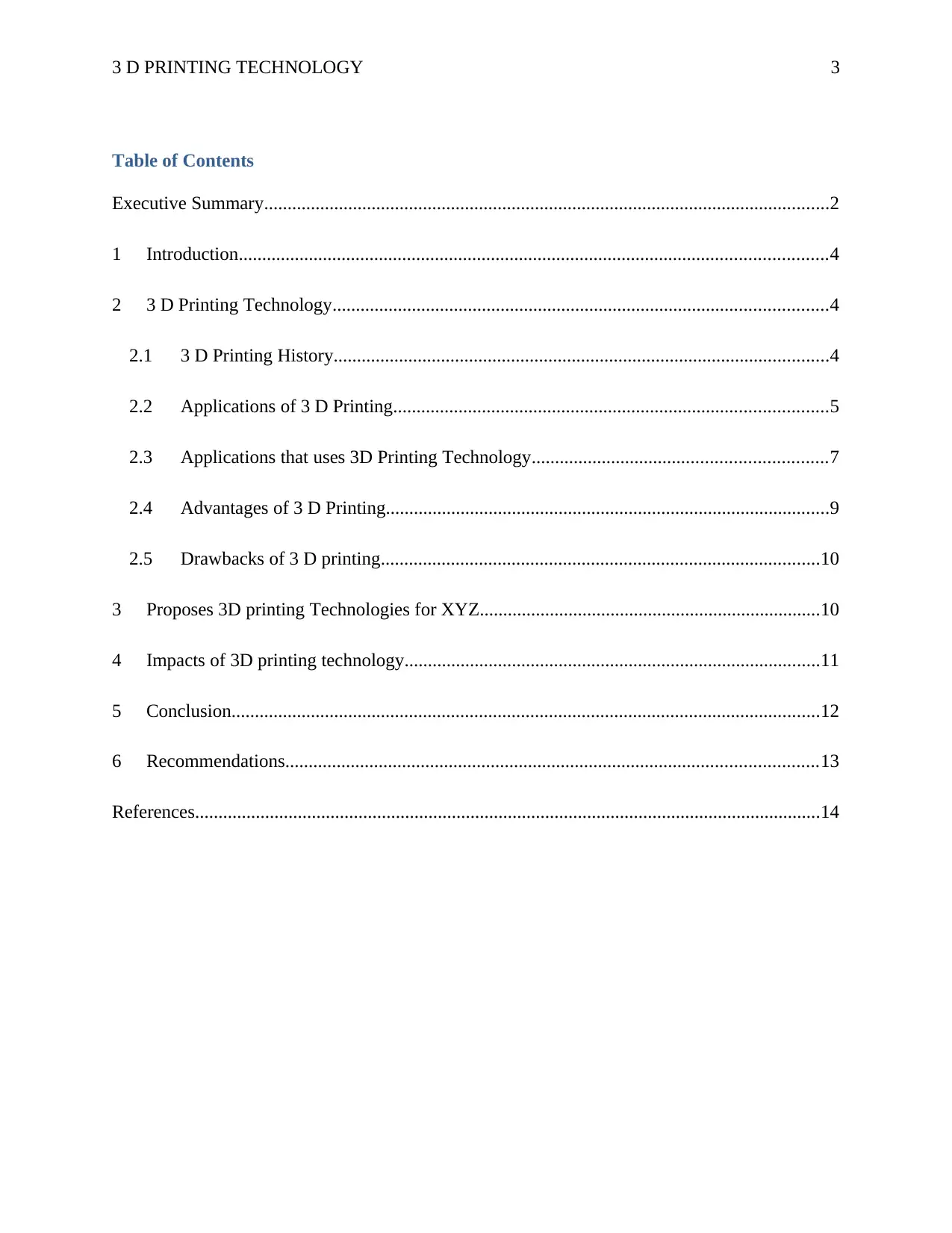
3 D PRINTING TECHNOLOGY 3
Table of Contents
Executive Summary.........................................................................................................................2
1 Introduction..............................................................................................................................4
2 3 D Printing Technology..........................................................................................................4
2.1 3 D Printing History..........................................................................................................4
2.2 Applications of 3 D Printing.............................................................................................5
2.3 Applications that uses 3D Printing Technology...............................................................7
2.4 Advantages of 3 D Printing...............................................................................................9
2.5 Drawbacks of 3 D printing..............................................................................................10
3 Proposes 3D printing Technologies for XYZ.........................................................................10
4 Impacts of 3D printing technology.........................................................................................11
5 Conclusion..............................................................................................................................12
6 Recommendations..................................................................................................................13
References......................................................................................................................................14
Table of Contents
Executive Summary.........................................................................................................................2
1 Introduction..............................................................................................................................4
2 3 D Printing Technology..........................................................................................................4
2.1 3 D Printing History..........................................................................................................4
2.2 Applications of 3 D Printing.............................................................................................5
2.3 Applications that uses 3D Printing Technology...............................................................7
2.4 Advantages of 3 D Printing...............................................................................................9
2.5 Drawbacks of 3 D printing..............................................................................................10
3 Proposes 3D printing Technologies for XYZ.........................................................................10
4 Impacts of 3D printing technology.........................................................................................11
5 Conclusion..............................................................................................................................12
6 Recommendations..................................................................................................................13
References......................................................................................................................................14
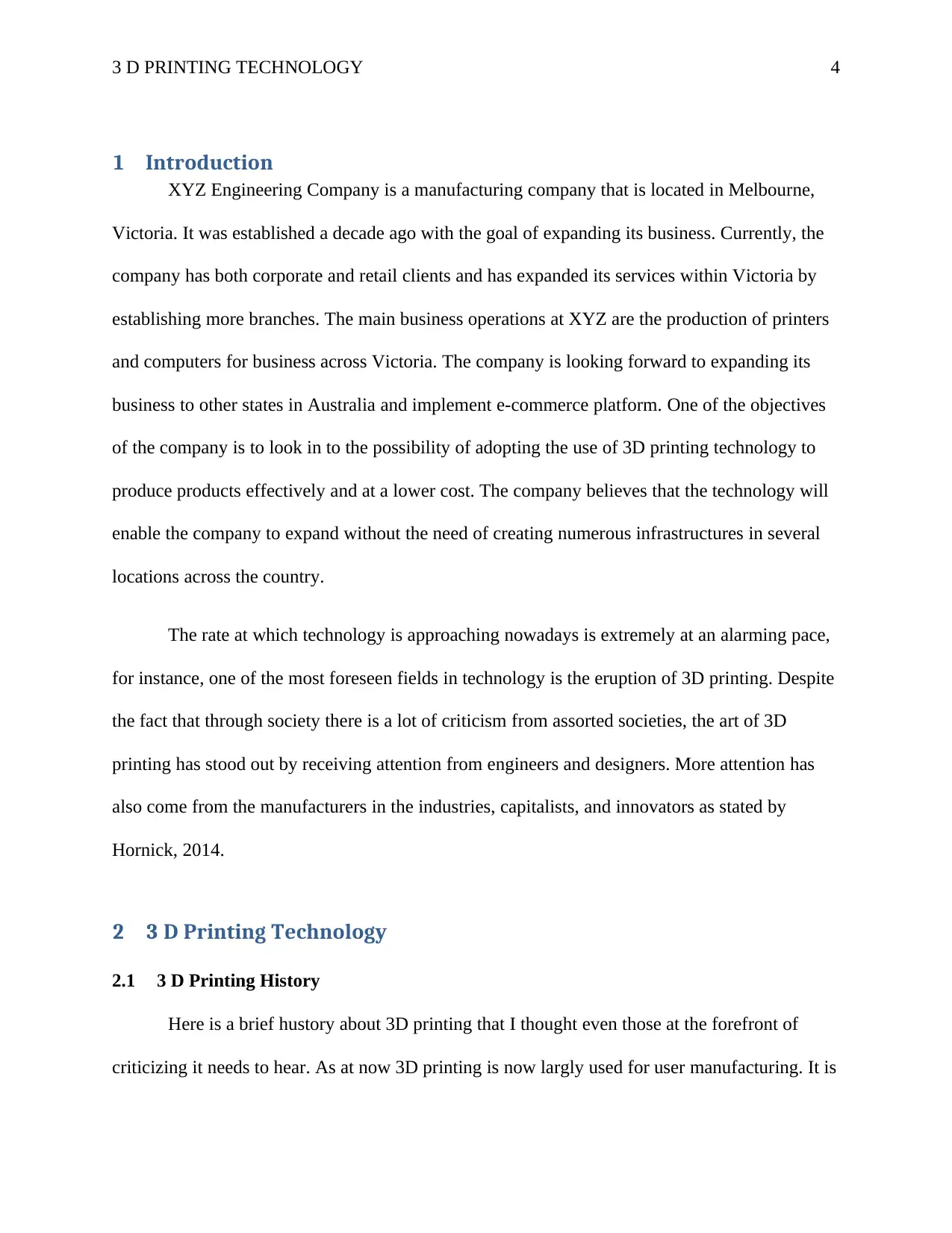
3 D PRINTING TECHNOLOGY 4
1 Introduction
XYZ Engineering Company is a manufacturing company that is located in Melbourne,
Victoria. It was established a decade ago with the goal of expanding its business. Currently, the
company has both corporate and retail clients and has expanded its services within Victoria by
establishing more branches. The main business operations at XYZ are the production of printers
and computers for business across Victoria. The company is looking forward to expanding its
business to other states in Australia and implement e-commerce platform. One of the objectives
of the company is to look in to the possibility of adopting the use of 3D printing technology to
produce products effectively and at a lower cost. The company believes that the technology will
enable the company to expand without the need of creating numerous infrastructures in several
locations across the country.
The rate at which technology is approaching nowadays is extremely at an alarming pace,
for instance, one of the most foreseen fields in technology is the eruption of 3D printing. Despite
the fact that through society there is a lot of criticism from assorted societies, the art of 3D
printing has stood out by receiving attention from engineers and designers. More attention has
also come from the manufacturers in the industries, capitalists, and innovators as stated by
Hornick, 2014.
2 3 D Printing Technology
2.1 3 D Printing History
Here is a brief hustory about 3D printing that I thought even those at the forefront of
criticizing it needs to hear. As at now 3D printing is now largly used for user manufacturing. It is
1 Introduction
XYZ Engineering Company is a manufacturing company that is located in Melbourne,
Victoria. It was established a decade ago with the goal of expanding its business. Currently, the
company has both corporate and retail clients and has expanded its services within Victoria by
establishing more branches. The main business operations at XYZ are the production of printers
and computers for business across Victoria. The company is looking forward to expanding its
business to other states in Australia and implement e-commerce platform. One of the objectives
of the company is to look in to the possibility of adopting the use of 3D printing technology to
produce products effectively and at a lower cost. The company believes that the technology will
enable the company to expand without the need of creating numerous infrastructures in several
locations across the country.
The rate at which technology is approaching nowadays is extremely at an alarming pace,
for instance, one of the most foreseen fields in technology is the eruption of 3D printing. Despite
the fact that through society there is a lot of criticism from assorted societies, the art of 3D
printing has stood out by receiving attention from engineers and designers. More attention has
also come from the manufacturers in the industries, capitalists, and innovators as stated by
Hornick, 2014.
2 3 D Printing Technology
2.1 3 D Printing History
Here is a brief hustory about 3D printing that I thought even those at the forefront of
criticizing it needs to hear. As at now 3D printing is now largly used for user manufacturing. It is
Secure Best Marks with AI Grader
Need help grading? Try our AI Grader for instant feedback on your assignments.
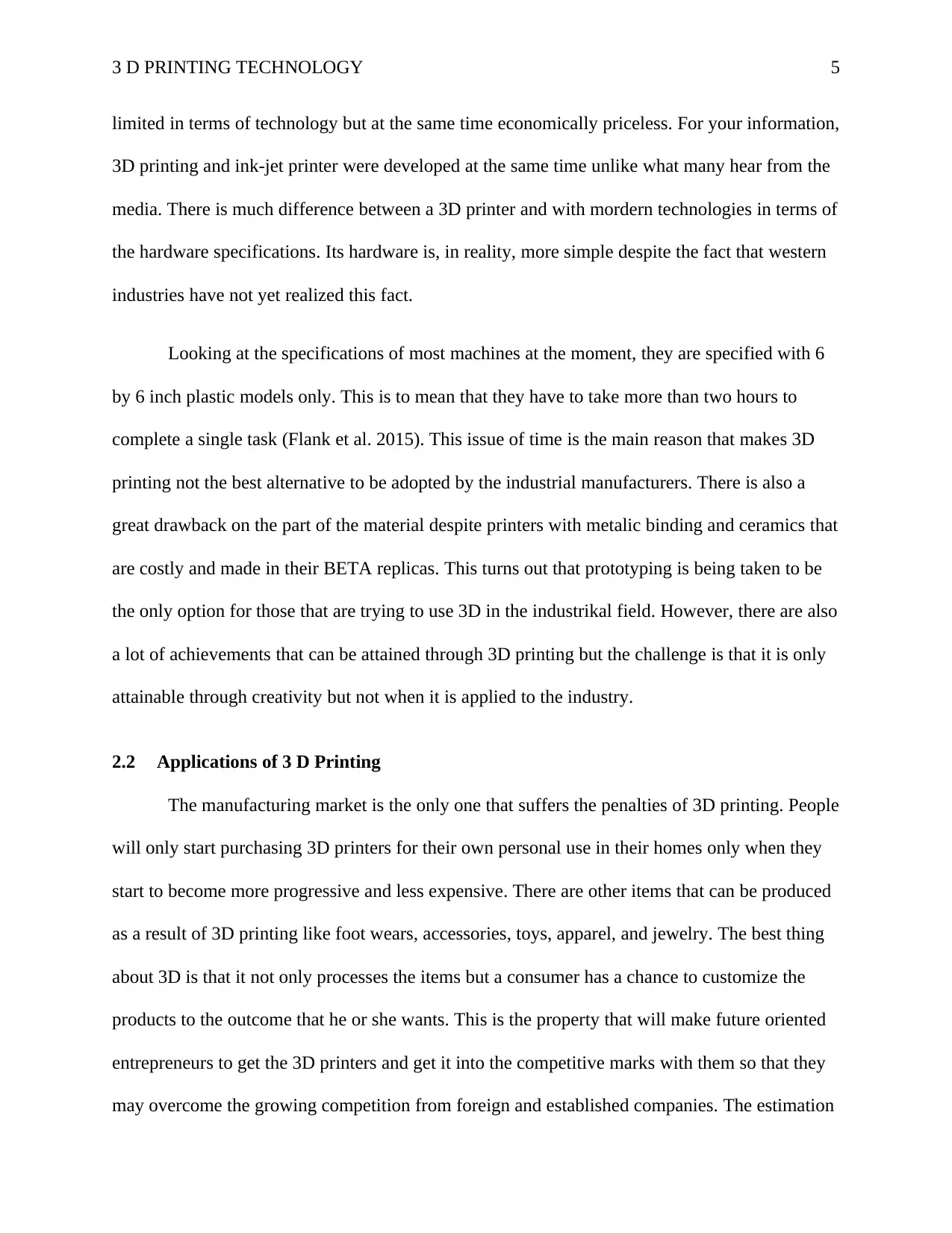
3 D PRINTING TECHNOLOGY 5
limited in terms of technology but at the same time economically priceless. For your information,
3D printing and ink-jet printer were developed at the same time unlike what many hear from the
media. There is much difference between a 3D printer and with mordern technologies in terms of
the hardware specifications. Its hardware is, in reality, more simple despite the fact that western
industries have not yet realized this fact.
Looking at the specifications of most machines at the moment, they are specified with 6
by 6 inch plastic models only. This is to mean that they have to take more than two hours to
complete a single task (Flank et al. 2015). This issue of time is the main reason that makes 3D
printing not the best alternative to be adopted by the industrial manufacturers. There is also a
great drawback on the part of the material despite printers with metalic binding and ceramics that
are costly and made in their BETA replicas. This turns out that prototyping is being taken to be
the only option for those that are trying to use 3D in the industrikal field. However, there are also
a lot of achievements that can be attained through 3D printing but the challenge is that it is only
attainable through creativity but not when it is applied to the industry.
2.2 Applications of 3 D Printing
The manufacturing market is the only one that suffers the penalties of 3D printing. People
will only start purchasing 3D printers for their own personal use in their homes only when they
start to become more progressive and less expensive. There are other items that can be produced
as a result of 3D printing like foot wears, accessories, toys, apparel, and jewelry. The best thing
about 3D is that it not only processes the items but a consumer has a chance to customize the
products to the outcome that he or she wants. This is the property that will make future oriented
entrepreneurs to get the 3D printers and get it into the competitive marks with them so that they
may overcome the growing competition from foreign and established companies. The estimation
limited in terms of technology but at the same time economically priceless. For your information,
3D printing and ink-jet printer were developed at the same time unlike what many hear from the
media. There is much difference between a 3D printer and with mordern technologies in terms of
the hardware specifications. Its hardware is, in reality, more simple despite the fact that western
industries have not yet realized this fact.
Looking at the specifications of most machines at the moment, they are specified with 6
by 6 inch plastic models only. This is to mean that they have to take more than two hours to
complete a single task (Flank et al. 2015). This issue of time is the main reason that makes 3D
printing not the best alternative to be adopted by the industrial manufacturers. There is also a
great drawback on the part of the material despite printers with metalic binding and ceramics that
are costly and made in their BETA replicas. This turns out that prototyping is being taken to be
the only option for those that are trying to use 3D in the industrikal field. However, there are also
a lot of achievements that can be attained through 3D printing but the challenge is that it is only
attainable through creativity but not when it is applied to the industry.
2.2 Applications of 3 D Printing
The manufacturing market is the only one that suffers the penalties of 3D printing. People
will only start purchasing 3D printers for their own personal use in their homes only when they
start to become more progressive and less expensive. There are other items that can be produced
as a result of 3D printing like foot wears, accessories, toys, apparel, and jewelry. The best thing
about 3D is that it not only processes the items but a consumer has a chance to customize the
products to the outcome that he or she wants. This is the property that will make future oriented
entrepreneurs to get the 3D printers and get it into the competitive marks with them so that they
may overcome the growing competition from foreign and established companies. The estimation
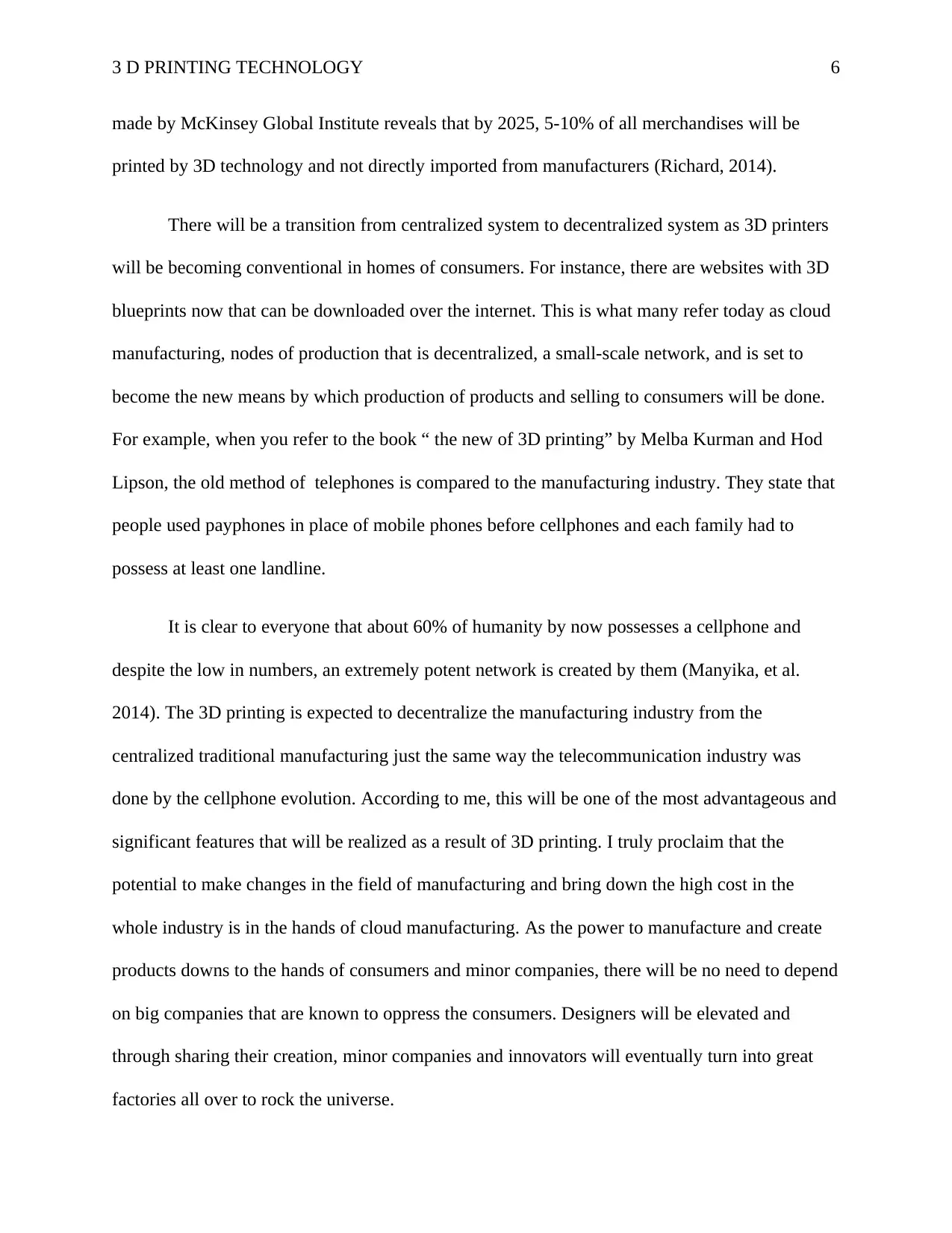
3 D PRINTING TECHNOLOGY 6
made by McKinsey Global Institute reveals that by 2025, 5-10% of all merchandises will be
printed by 3D technology and not directly imported from manufacturers (Richard, 2014).
There will be a transition from centralized system to decentralized system as 3D printers
will be becoming conventional in homes of consumers. For instance, there are websites with 3D
blueprints now that can be downloaded over the internet. This is what many refer today as cloud
manufacturing, nodes of production that is decentralized, a small-scale network, and is set to
become the new means by which production of products and selling to consumers will be done.
For example, when you refer to the book “ the new of 3D printing” by Melba Kurman and Hod
Lipson, the old method of telephones is compared to the manufacturing industry. They state that
people used payphones in place of mobile phones before cellphones and each family had to
possess at least one landline.
It is clear to everyone that about 60% of humanity by now possesses a cellphone and
despite the low in numbers, an extremely potent network is created by them (Manyika, et al.
2014). The 3D printing is expected to decentralize the manufacturing industry from the
centralized traditional manufacturing just the same way the telecommunication industry was
done by the cellphone evolution. According to me, this will be one of the most advantageous and
significant features that will be realized as a result of 3D printing. I truly proclaim that the
potential to make changes in the field of manufacturing and bring down the high cost in the
whole industry is in the hands of cloud manufacturing. As the power to manufacture and create
products downs to the hands of consumers and minor companies, there will be no need to depend
on big companies that are known to oppress the consumers. Designers will be elevated and
through sharing their creation, minor companies and innovators will eventually turn into great
factories all over to rock the universe.
made by McKinsey Global Institute reveals that by 2025, 5-10% of all merchandises will be
printed by 3D technology and not directly imported from manufacturers (Richard, 2014).
There will be a transition from centralized system to decentralized system as 3D printers
will be becoming conventional in homes of consumers. For instance, there are websites with 3D
blueprints now that can be downloaded over the internet. This is what many refer today as cloud
manufacturing, nodes of production that is decentralized, a small-scale network, and is set to
become the new means by which production of products and selling to consumers will be done.
For example, when you refer to the book “ the new of 3D printing” by Melba Kurman and Hod
Lipson, the old method of telephones is compared to the manufacturing industry. They state that
people used payphones in place of mobile phones before cellphones and each family had to
possess at least one landline.
It is clear to everyone that about 60% of humanity by now possesses a cellphone and
despite the low in numbers, an extremely potent network is created by them (Manyika, et al.
2014). The 3D printing is expected to decentralize the manufacturing industry from the
centralized traditional manufacturing just the same way the telecommunication industry was
done by the cellphone evolution. According to me, this will be one of the most advantageous and
significant features that will be realized as a result of 3D printing. I truly proclaim that the
potential to make changes in the field of manufacturing and bring down the high cost in the
whole industry is in the hands of cloud manufacturing. As the power to manufacture and create
products downs to the hands of consumers and minor companies, there will be no need to depend
on big companies that are known to oppress the consumers. Designers will be elevated and
through sharing their creation, minor companies and innovators will eventually turn into great
factories all over to rock the universe.
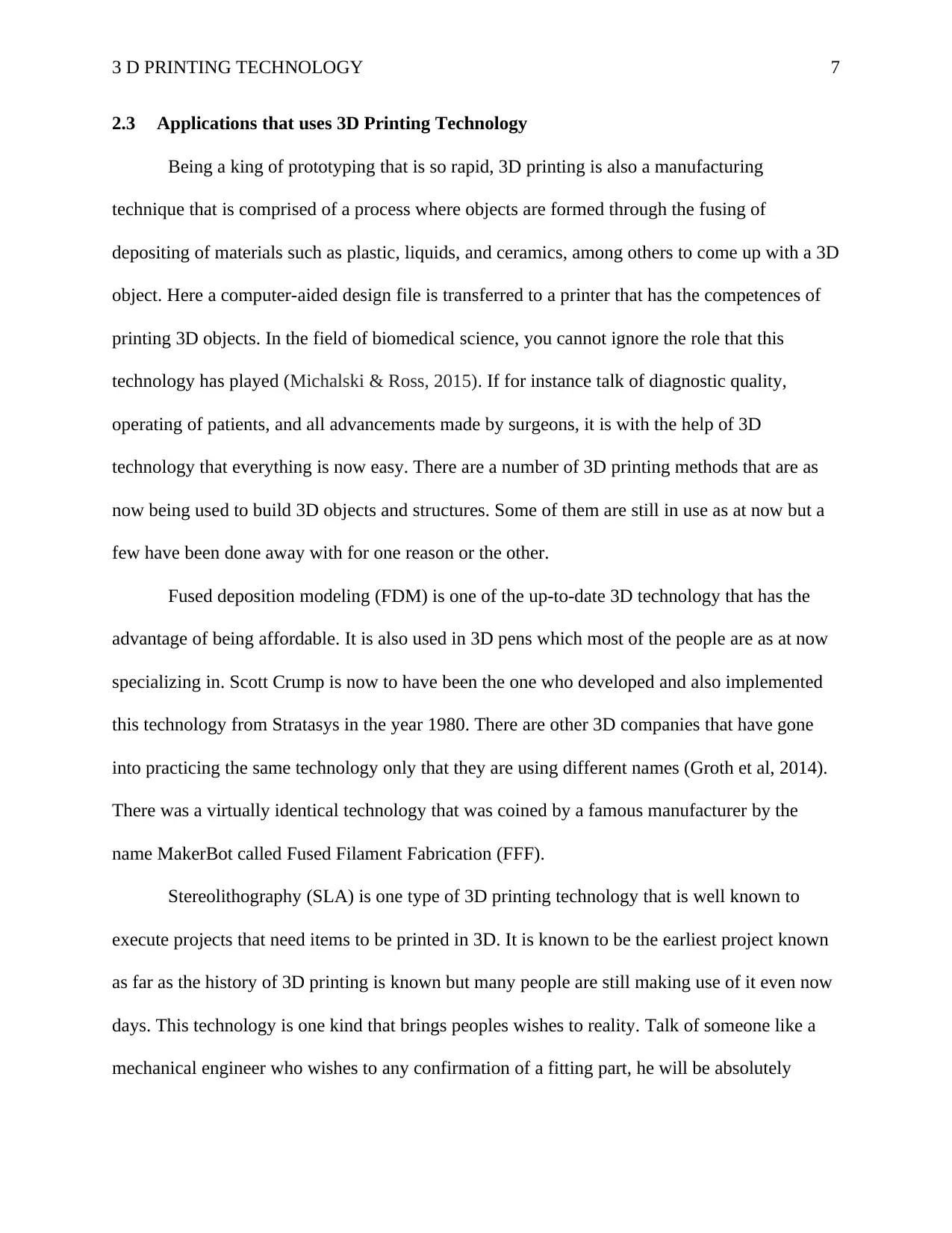
3 D PRINTING TECHNOLOGY 7
2.3 Applications that uses 3D Printing Technology
Being a king of prototyping that is so rapid, 3D printing is also a manufacturing
technique that is comprised of a process where objects are formed through the fusing of
depositing of materials such as plastic, liquids, and ceramics, among others to come up with a 3D
object. Here a computer-aided design file is transferred to a printer that has the competences of
printing 3D objects. In the field of biomedical science, you cannot ignore the role that this
technology has played (Michalski & Ross, 2015). If for instance talk of diagnostic quality,
operating of patients, and all advancements made by surgeons, it is with the help of 3D
technology that everything is now easy. There are a number of 3D printing methods that are as
now being used to build 3D objects and structures. Some of them are still in use as at now but a
few have been done away with for one reason or the other.
Fused deposition modeling (FDM) is one of the up-to-date 3D technology that has the
advantage of being affordable. It is also used in 3D pens which most of the people are as at now
specializing in. Scott Crump is now to have been the one who developed and also implemented
this technology from Stratasys in the year 1980. There are other 3D companies that have gone
into practicing the same technology only that they are using different names (Groth et al, 2014).
There was a virtually identical technology that was coined by a famous manufacturer by the
name MakerBot called Fused Filament Fabrication (FFF).
Stereolithography (SLA) is one type of 3D printing technology that is well known to
execute projects that need items to be printed in 3D. It is known to be the earliest project known
as far as the history of 3D printing is known but many people are still making use of it even now
days. This technology is one kind that brings peoples wishes to reality. Talk of someone like a
mechanical engineer who wishes to any confirmation of a fitting part, he will be absolutely
2.3 Applications that uses 3D Printing Technology
Being a king of prototyping that is so rapid, 3D printing is also a manufacturing
technique that is comprised of a process where objects are formed through the fusing of
depositing of materials such as plastic, liquids, and ceramics, among others to come up with a 3D
object. Here a computer-aided design file is transferred to a printer that has the competences of
printing 3D objects. In the field of biomedical science, you cannot ignore the role that this
technology has played (Michalski & Ross, 2015). If for instance talk of diagnostic quality,
operating of patients, and all advancements made by surgeons, it is with the help of 3D
technology that everything is now easy. There are a number of 3D printing methods that are as
now being used to build 3D objects and structures. Some of them are still in use as at now but a
few have been done away with for one reason or the other.
Fused deposition modeling (FDM) is one of the up-to-date 3D technology that has the
advantage of being affordable. It is also used in 3D pens which most of the people are as at now
specializing in. Scott Crump is now to have been the one who developed and also implemented
this technology from Stratasys in the year 1980. There are other 3D companies that have gone
into practicing the same technology only that they are using different names (Groth et al, 2014).
There was a virtually identical technology that was coined by a famous manufacturer by the
name MakerBot called Fused Filament Fabrication (FFF).
Stereolithography (SLA) is one type of 3D printing technology that is well known to
execute projects that need items to be printed in 3D. It is known to be the earliest project known
as far as the history of 3D printing is known but many people are still making use of it even now
days. This technology is one kind that brings peoples wishes to reality. Talk of someone like a
mechanical engineer who wishes to any confirmation of a fitting part, he will be absolutely
Paraphrase This Document
Need a fresh take? Get an instant paraphrase of this document with our AI Paraphraser
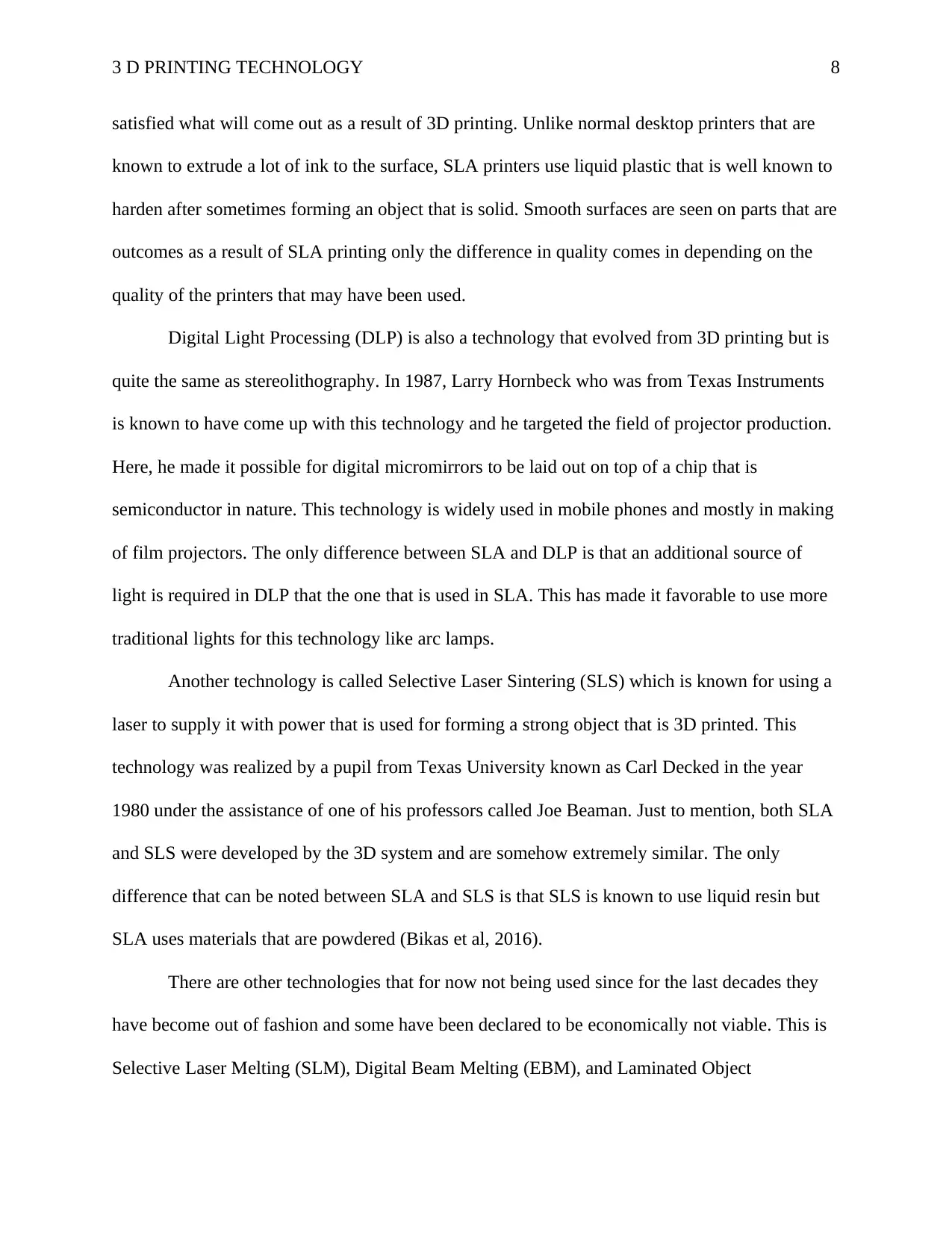
3 D PRINTING TECHNOLOGY 8
satisfied what will come out as a result of 3D printing. Unlike normal desktop printers that are
known to extrude a lot of ink to the surface, SLA printers use liquid plastic that is well known to
harden after sometimes forming an object that is solid. Smooth surfaces are seen on parts that are
outcomes as a result of SLA printing only the difference in quality comes in depending on the
quality of the printers that may have been used.
Digital Light Processing (DLP) is also a technology that evolved from 3D printing but is
quite the same as stereolithography. In 1987, Larry Hornbeck who was from Texas Instruments
is known to have come up with this technology and he targeted the field of projector production.
Here, he made it possible for digital micromirrors to be laid out on top of a chip that is
semiconductor in nature. This technology is widely used in mobile phones and mostly in making
of film projectors. The only difference between SLA and DLP is that an additional source of
light is required in DLP that the one that is used in SLA. This has made it favorable to use more
traditional lights for this technology like arc lamps.
Another technology is called Selective Laser Sintering (SLS) which is known for using a
laser to supply it with power that is used for forming a strong object that is 3D printed. This
technology was realized by a pupil from Texas University known as Carl Decked in the year
1980 under the assistance of one of his professors called Joe Beaman. Just to mention, both SLA
and SLS were developed by the 3D system and are somehow extremely similar. The only
difference that can be noted between SLA and SLS is that SLS is known to use liquid resin but
SLA uses materials that are powdered (Bikas et al, 2016).
There are other technologies that for now not being used since for the last decades they
have become out of fashion and some have been declared to be economically not viable. This is
Selective Laser Melting (SLM), Digital Beam Melting (EBM), and Laminated Object
satisfied what will come out as a result of 3D printing. Unlike normal desktop printers that are
known to extrude a lot of ink to the surface, SLA printers use liquid plastic that is well known to
harden after sometimes forming an object that is solid. Smooth surfaces are seen on parts that are
outcomes as a result of SLA printing only the difference in quality comes in depending on the
quality of the printers that may have been used.
Digital Light Processing (DLP) is also a technology that evolved from 3D printing but is
quite the same as stereolithography. In 1987, Larry Hornbeck who was from Texas Instruments
is known to have come up with this technology and he targeted the field of projector production.
Here, he made it possible for digital micromirrors to be laid out on top of a chip that is
semiconductor in nature. This technology is widely used in mobile phones and mostly in making
of film projectors. The only difference between SLA and DLP is that an additional source of
light is required in DLP that the one that is used in SLA. This has made it favorable to use more
traditional lights for this technology like arc lamps.
Another technology is called Selective Laser Sintering (SLS) which is known for using a
laser to supply it with power that is used for forming a strong object that is 3D printed. This
technology was realized by a pupil from Texas University known as Carl Decked in the year
1980 under the assistance of one of his professors called Joe Beaman. Just to mention, both SLA
and SLS were developed by the 3D system and are somehow extremely similar. The only
difference that can be noted between SLA and SLS is that SLS is known to use liquid resin but
SLA uses materials that are powdered (Bikas et al, 2016).
There are other technologies that for now not being used since for the last decades they
have become out of fashion and some have been declared to be economically not viable. This is
Selective Laser Melting (SLM), Digital Beam Melting (EBM), and Laminated Object
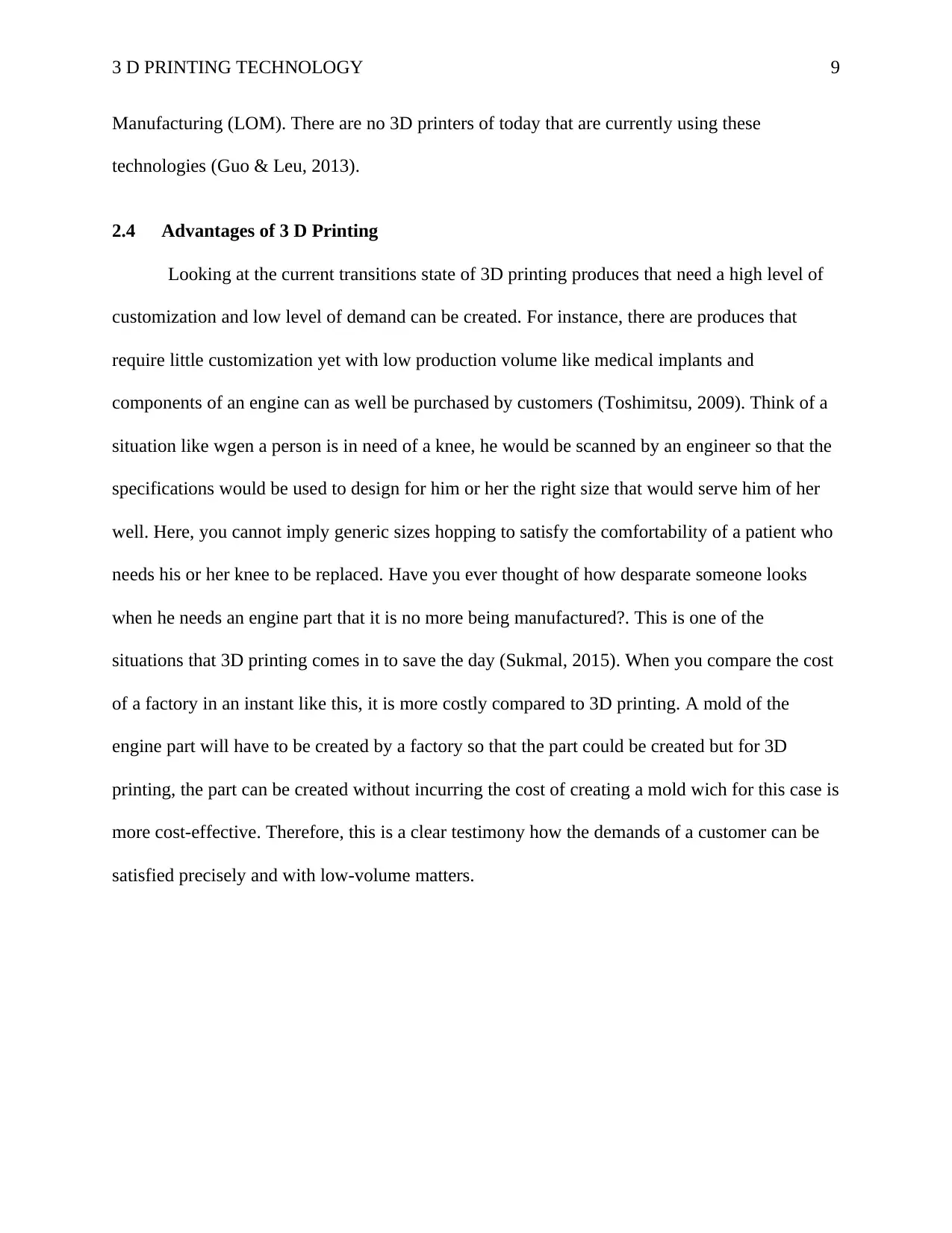
3 D PRINTING TECHNOLOGY 9
Manufacturing (LOM). There are no 3D printers of today that are currently using these
technologies (Guo & Leu, 2013).
2.4 Advantages of 3 D Printing
Looking at the current transitions state of 3D printing produces that need a high level of
customization and low level of demand can be created. For instance, there are produces that
require little customization yet with low production volume like medical implants and
components of an engine can as well be purchased by customers (Toshimitsu, 2009). Think of a
situation like wgen a person is in need of a knee, he would be scanned by an engineer so that the
specifications would be used to design for him or her the right size that would serve him of her
well. Here, you cannot imply generic sizes hopping to satisfy the comfortability of a patient who
needs his or her knee to be replaced. Have you ever thought of how desparate someone looks
when he needs an engine part that it is no more being manufactured?. This is one of the
situations that 3D printing comes in to save the day (Sukmal, 2015). When you compare the cost
of a factory in an instant like this, it is more costly compared to 3D printing. A mold of the
engine part will have to be created by a factory so that the part could be created but for 3D
printing, the part can be created without incurring the cost of creating a mold wich for this case is
more cost-effective. Therefore, this is a clear testimony how the demands of a customer can be
satisfied precisely and with low-volume matters.
Manufacturing (LOM). There are no 3D printers of today that are currently using these
technologies (Guo & Leu, 2013).
2.4 Advantages of 3 D Printing
Looking at the current transitions state of 3D printing produces that need a high level of
customization and low level of demand can be created. For instance, there are produces that
require little customization yet with low production volume like medical implants and
components of an engine can as well be purchased by customers (Toshimitsu, 2009). Think of a
situation like wgen a person is in need of a knee, he would be scanned by an engineer so that the
specifications would be used to design for him or her the right size that would serve him of her
well. Here, you cannot imply generic sizes hopping to satisfy the comfortability of a patient who
needs his or her knee to be replaced. Have you ever thought of how desparate someone looks
when he needs an engine part that it is no more being manufactured?. This is one of the
situations that 3D printing comes in to save the day (Sukmal, 2015). When you compare the cost
of a factory in an instant like this, it is more costly compared to 3D printing. A mold of the
engine part will have to be created by a factory so that the part could be created but for 3D
printing, the part can be created without incurring the cost of creating a mold wich for this case is
more cost-effective. Therefore, this is a clear testimony how the demands of a customer can be
satisfied precisely and with low-volume matters.
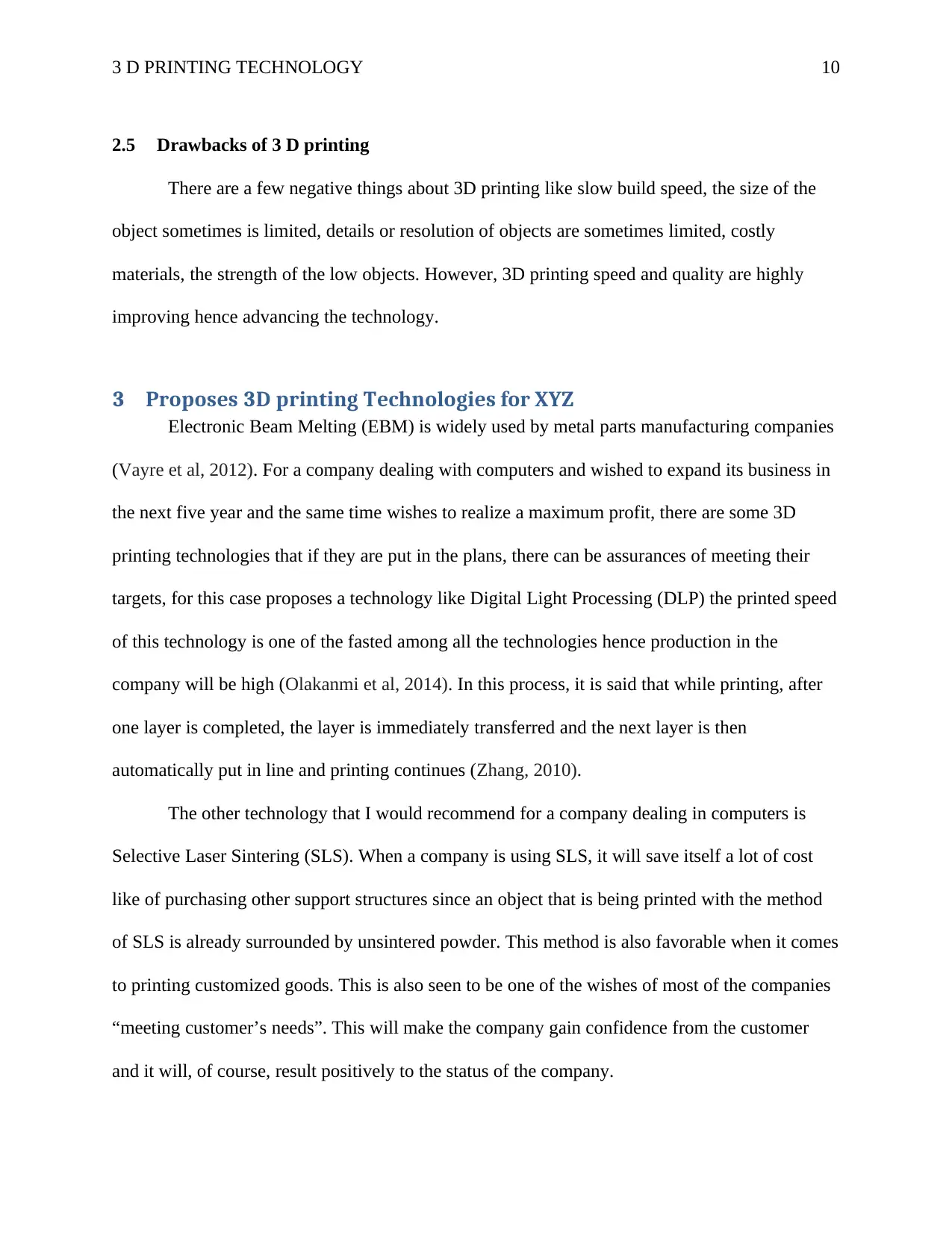
3 D PRINTING TECHNOLOGY 10
2.5 Drawbacks of 3 D printing
There are a few negative things about 3D printing like slow build speed, the size of the
object sometimes is limited, details or resolution of objects are sometimes limited, costly
materials, the strength of the low objects. However, 3D printing speed and quality are highly
improving hence advancing the technology.
3 Proposes 3D printing Technologies for XYZ
Electronic Beam Melting (EBM) is widely used by metal parts manufacturing companies
(Vayre et al, 2012). For a company dealing with computers and wished to expand its business in
the next five year and the same time wishes to realize a maximum profit, there are some 3D
printing technologies that if they are put in the plans, there can be assurances of meeting their
targets, for this case proposes a technology like Digital Light Processing (DLP) the printed speed
of this technology is one of the fasted among all the technologies hence production in the
company will be high (Olakanmi et al, 2014). In this process, it is said that while printing, after
one layer is completed, the layer is immediately transferred and the next layer is then
automatically put in line and printing continues (Zhang, 2010).
The other technology that I would recommend for a company dealing in computers is
Selective Laser Sintering (SLS). When a company is using SLS, it will save itself a lot of cost
like of purchasing other support structures since an object that is being printed with the method
of SLS is already surrounded by unsintered powder. This method is also favorable when it comes
to printing customized goods. This is also seen to be one of the wishes of most of the companies
“meeting customer’s needs”. This will make the company gain confidence from the customer
and it will, of course, result positively to the status of the company.
2.5 Drawbacks of 3 D printing
There are a few negative things about 3D printing like slow build speed, the size of the
object sometimes is limited, details or resolution of objects are sometimes limited, costly
materials, the strength of the low objects. However, 3D printing speed and quality are highly
improving hence advancing the technology.
3 Proposes 3D printing Technologies for XYZ
Electronic Beam Melting (EBM) is widely used by metal parts manufacturing companies
(Vayre et al, 2012). For a company dealing with computers and wished to expand its business in
the next five year and the same time wishes to realize a maximum profit, there are some 3D
printing technologies that if they are put in the plans, there can be assurances of meeting their
targets, for this case proposes a technology like Digital Light Processing (DLP) the printed speed
of this technology is one of the fasted among all the technologies hence production in the
company will be high (Olakanmi et al, 2014). In this process, it is said that while printing, after
one layer is completed, the layer is immediately transferred and the next layer is then
automatically put in line and printing continues (Zhang, 2010).
The other technology that I would recommend for a company dealing in computers is
Selective Laser Sintering (SLS). When a company is using SLS, it will save itself a lot of cost
like of purchasing other support structures since an object that is being printed with the method
of SLS is already surrounded by unsintered powder. This method is also favorable when it comes
to printing customized goods. This is also seen to be one of the wishes of most of the companies
“meeting customer’s needs”. This will make the company gain confidence from the customer
and it will, of course, result positively to the status of the company.
Secure Best Marks with AI Grader
Need help grading? Try our AI Grader for instant feedback on your assignments.
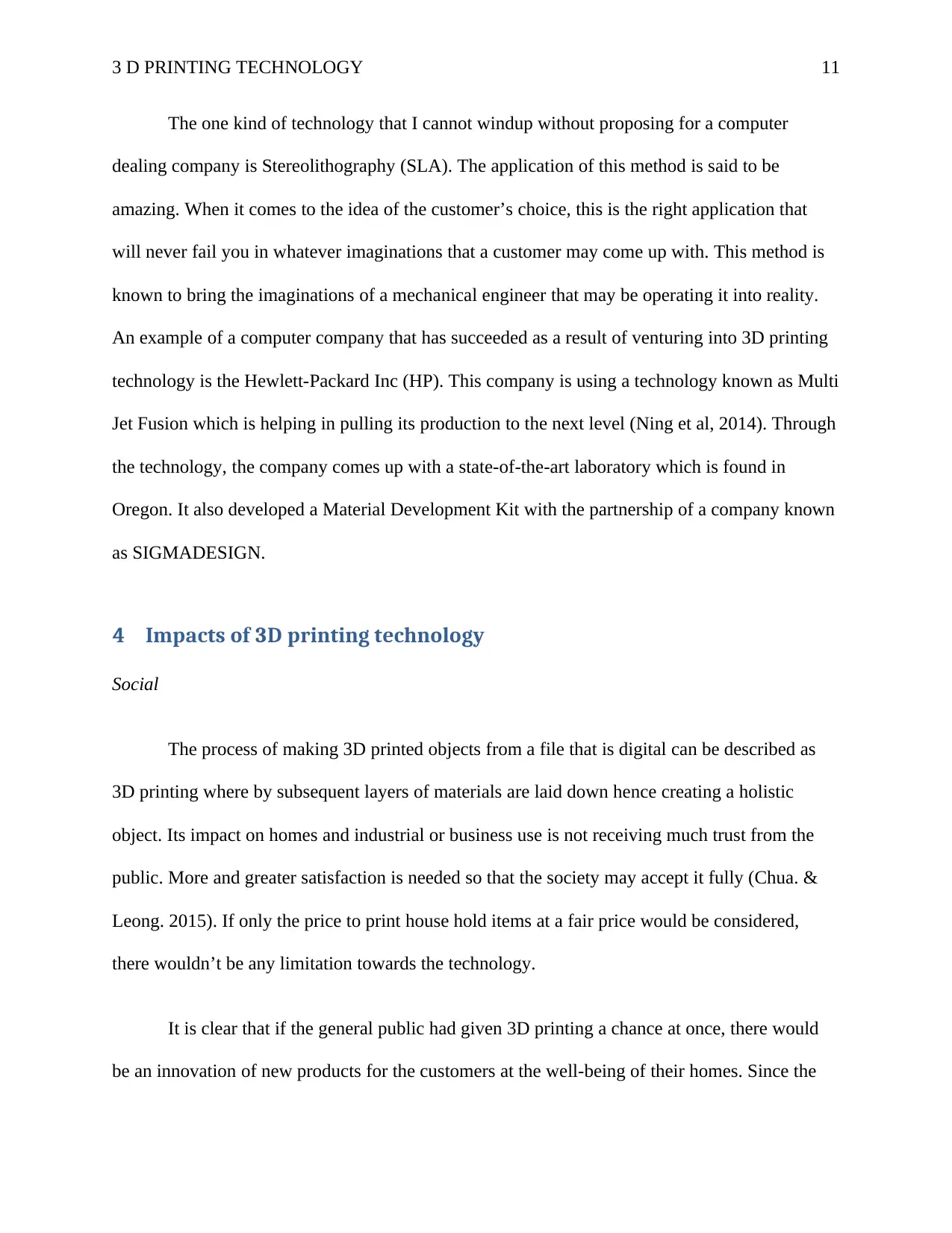
3 D PRINTING TECHNOLOGY 11
The one kind of technology that I cannot windup without proposing for a computer
dealing company is Stereolithography (SLA). The application of this method is said to be
amazing. When it comes to the idea of the customer’s choice, this is the right application that
will never fail you in whatever imaginations that a customer may come up with. This method is
known to bring the imaginations of a mechanical engineer that may be operating it into reality.
An example of a computer company that has succeeded as a result of venturing into 3D printing
technology is the Hewlett-Packard Inc (HP). This company is using a technology known as Multi
Jet Fusion which is helping in pulling its production to the next level (Ning et al, 2014). Through
the technology, the company comes up with a state-of-the-art laboratory which is found in
Oregon. It also developed a Material Development Kit with the partnership of a company known
as SIGMADESIGN.
4 Impacts of 3D printing technology
Social
The process of making 3D printed objects from a file that is digital can be described as
3D printing where by subsequent layers of materials are laid down hence creating a holistic
object. Its impact on homes and industrial or business use is not receiving much trust from the
public. More and greater satisfaction is needed so that the society may accept it fully (Chua. &
Leong. 2015). If only the price to print house hold items at a fair price would be considered,
there wouldn’t be any limitation towards the technology.
It is clear that if the general public had given 3D printing a chance at once, there would
be an innovation of new products for the customers at the well-being of their homes. Since the
The one kind of technology that I cannot windup without proposing for a computer
dealing company is Stereolithography (SLA). The application of this method is said to be
amazing. When it comes to the idea of the customer’s choice, this is the right application that
will never fail you in whatever imaginations that a customer may come up with. This method is
known to bring the imaginations of a mechanical engineer that may be operating it into reality.
An example of a computer company that has succeeded as a result of venturing into 3D printing
technology is the Hewlett-Packard Inc (HP). This company is using a technology known as Multi
Jet Fusion which is helping in pulling its production to the next level (Ning et al, 2014). Through
the technology, the company comes up with a state-of-the-art laboratory which is found in
Oregon. It also developed a Material Development Kit with the partnership of a company known
as SIGMADESIGN.
4 Impacts of 3D printing technology
Social
The process of making 3D printed objects from a file that is digital can be described as
3D printing where by subsequent layers of materials are laid down hence creating a holistic
object. Its impact on homes and industrial or business use is not receiving much trust from the
public. More and greater satisfaction is needed so that the society may accept it fully (Chua. &
Leong. 2015). If only the price to print house hold items at a fair price would be considered,
there wouldn’t be any limitation towards the technology.
It is clear that if the general public had given 3D printing a chance at once, there would
be an innovation of new products for the customers at the well-being of their homes. Since the
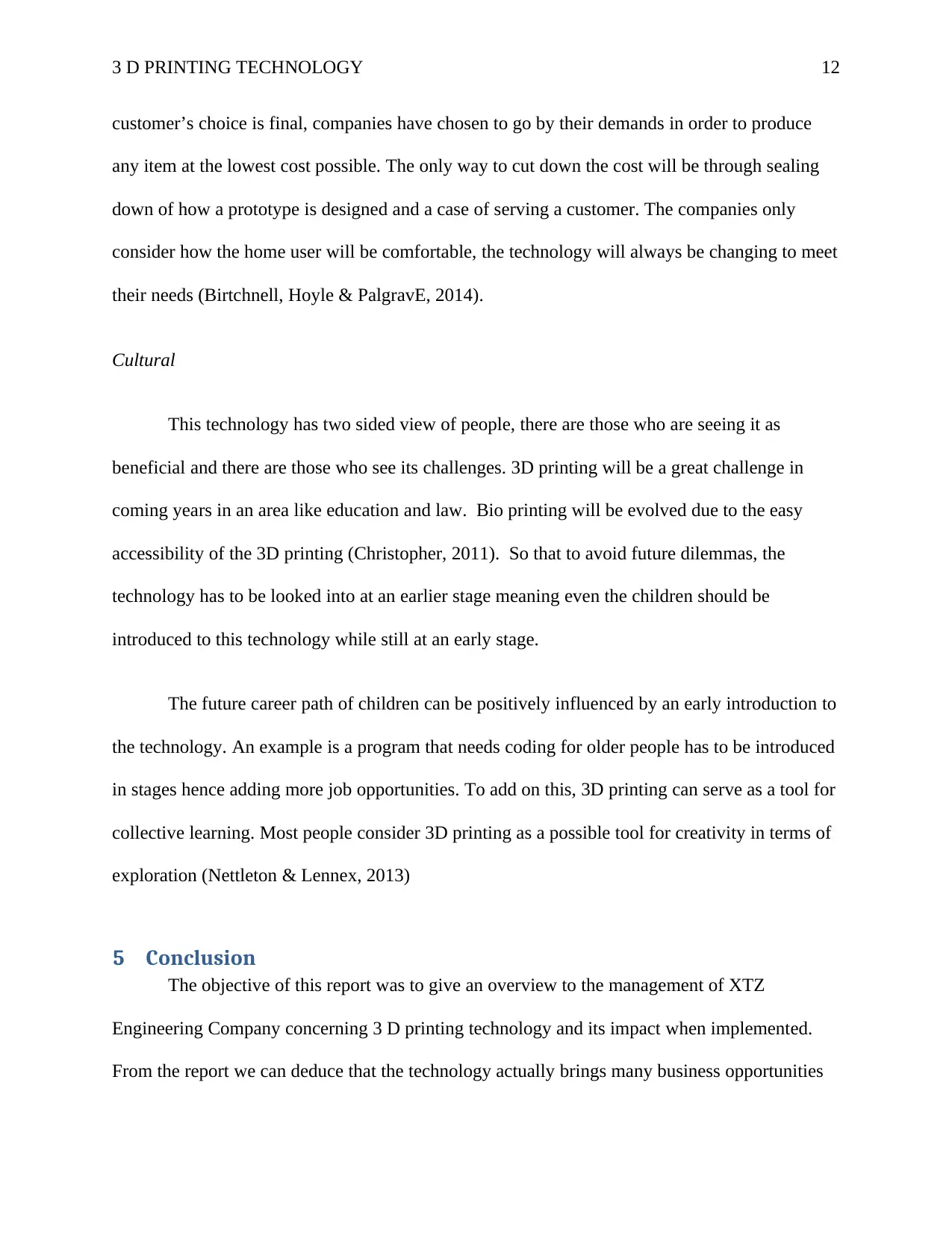
3 D PRINTING TECHNOLOGY 12
customer’s choice is final, companies have chosen to go by their demands in order to produce
any item at the lowest cost possible. The only way to cut down the cost will be through sealing
down of how a prototype is designed and a case of serving a customer. The companies only
consider how the home user will be comfortable, the technology will always be changing to meet
their needs (Birtchnell, Hoyle & PalgravE, 2014).
Cultural
This technology has two sided view of people, there are those who are seeing it as
beneficial and there are those who see its challenges. 3D printing will be a great challenge in
coming years in an area like education and law. Bio printing will be evolved due to the easy
accessibility of the 3D printing (Christopher, 2011). So that to avoid future dilemmas, the
technology has to be looked into at an earlier stage meaning even the children should be
introduced to this technology while still at an early stage.
The future career path of children can be positively influenced by an early introduction to
the technology. An example is a program that needs coding for older people has to be introduced
in stages hence adding more job opportunities. To add on this, 3D printing can serve as a tool for
collective learning. Most people consider 3D printing as a possible tool for creativity in terms of
exploration (Nettleton & Lennex, 2013)
5 Conclusion
The objective of this report was to give an overview to the management of XTZ
Engineering Company concerning 3 D printing technology and its impact when implemented.
From the report we can deduce that the technology actually brings many business opportunities
customer’s choice is final, companies have chosen to go by their demands in order to produce
any item at the lowest cost possible. The only way to cut down the cost will be through sealing
down of how a prototype is designed and a case of serving a customer. The companies only
consider how the home user will be comfortable, the technology will always be changing to meet
their needs (Birtchnell, Hoyle & PalgravE, 2014).
Cultural
This technology has two sided view of people, there are those who are seeing it as
beneficial and there are those who see its challenges. 3D printing will be a great challenge in
coming years in an area like education and law. Bio printing will be evolved due to the easy
accessibility of the 3D printing (Christopher, 2011). So that to avoid future dilemmas, the
technology has to be looked into at an earlier stage meaning even the children should be
introduced to this technology while still at an early stage.
The future career path of children can be positively influenced by an early introduction to
the technology. An example is a program that needs coding for older people has to be introduced
in stages hence adding more job opportunities. To add on this, 3D printing can serve as a tool for
collective learning. Most people consider 3D printing as a possible tool for creativity in terms of
exploration (Nettleton & Lennex, 2013)
5 Conclusion
The objective of this report was to give an overview to the management of XTZ
Engineering Company concerning 3 D printing technology and its impact when implemented.
From the report we can deduce that the technology actually brings many business opportunities
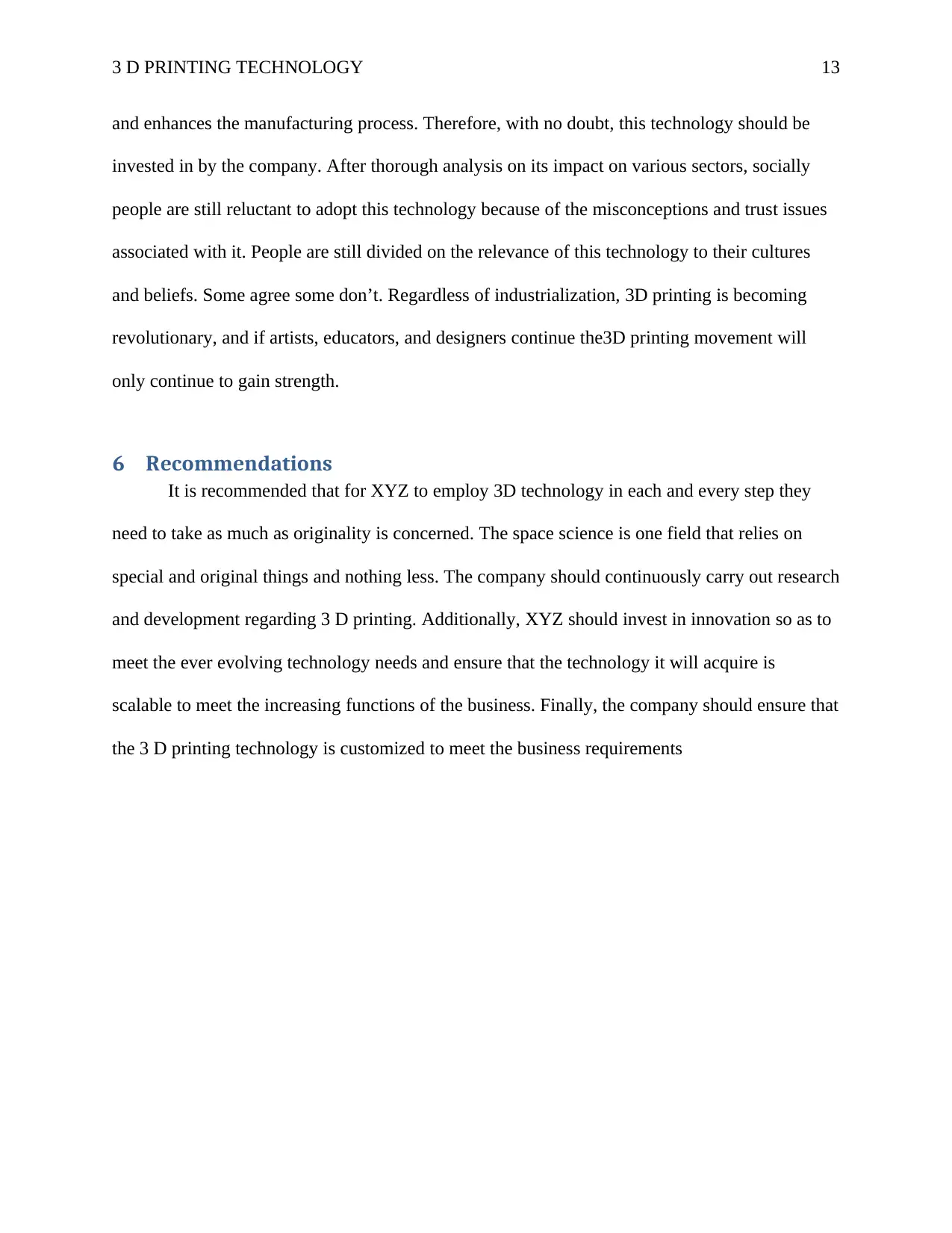
3 D PRINTING TECHNOLOGY 13
and enhances the manufacturing process. Therefore, with no doubt, this technology should be
invested in by the company. After thorough analysis on its impact on various sectors, socially
people are still reluctant to adopt this technology because of the misconceptions and trust issues
associated with it. People are still divided on the relevance of this technology to their cultures
and beliefs. Some agree some don’t. Regardless of industrialization, 3D printing is becoming
revolutionary, and if artists, educators, and designers continue the3D printing movement will
only continue to gain strength.
6 Recommendations
It is recommended that for XYZ to employ 3D technology in each and every step they
need to take as much as originality is concerned. The space science is one field that relies on
special and original things and nothing less. The company should continuously carry out research
and development regarding 3 D printing. Additionally, XYZ should invest in innovation so as to
meet the ever evolving technology needs and ensure that the technology it will acquire is
scalable to meet the increasing functions of the business. Finally, the company should ensure that
the 3 D printing technology is customized to meet the business requirements
and enhances the manufacturing process. Therefore, with no doubt, this technology should be
invested in by the company. After thorough analysis on its impact on various sectors, socially
people are still reluctant to adopt this technology because of the misconceptions and trust issues
associated with it. People are still divided on the relevance of this technology to their cultures
and beliefs. Some agree some don’t. Regardless of industrialization, 3D printing is becoming
revolutionary, and if artists, educators, and designers continue the3D printing movement will
only continue to gain strength.
6 Recommendations
It is recommended that for XYZ to employ 3D technology in each and every step they
need to take as much as originality is concerned. The space science is one field that relies on
special and original things and nothing less. The company should continuously carry out research
and development regarding 3 D printing. Additionally, XYZ should invest in innovation so as to
meet the ever evolving technology needs and ensure that the technology it will acquire is
scalable to meet the increasing functions of the business. Finally, the company should ensure that
the 3 D printing technology is customized to meet the business requirements
Paraphrase This Document
Need a fresh take? Get an instant paraphrase of this document with our AI Paraphraser
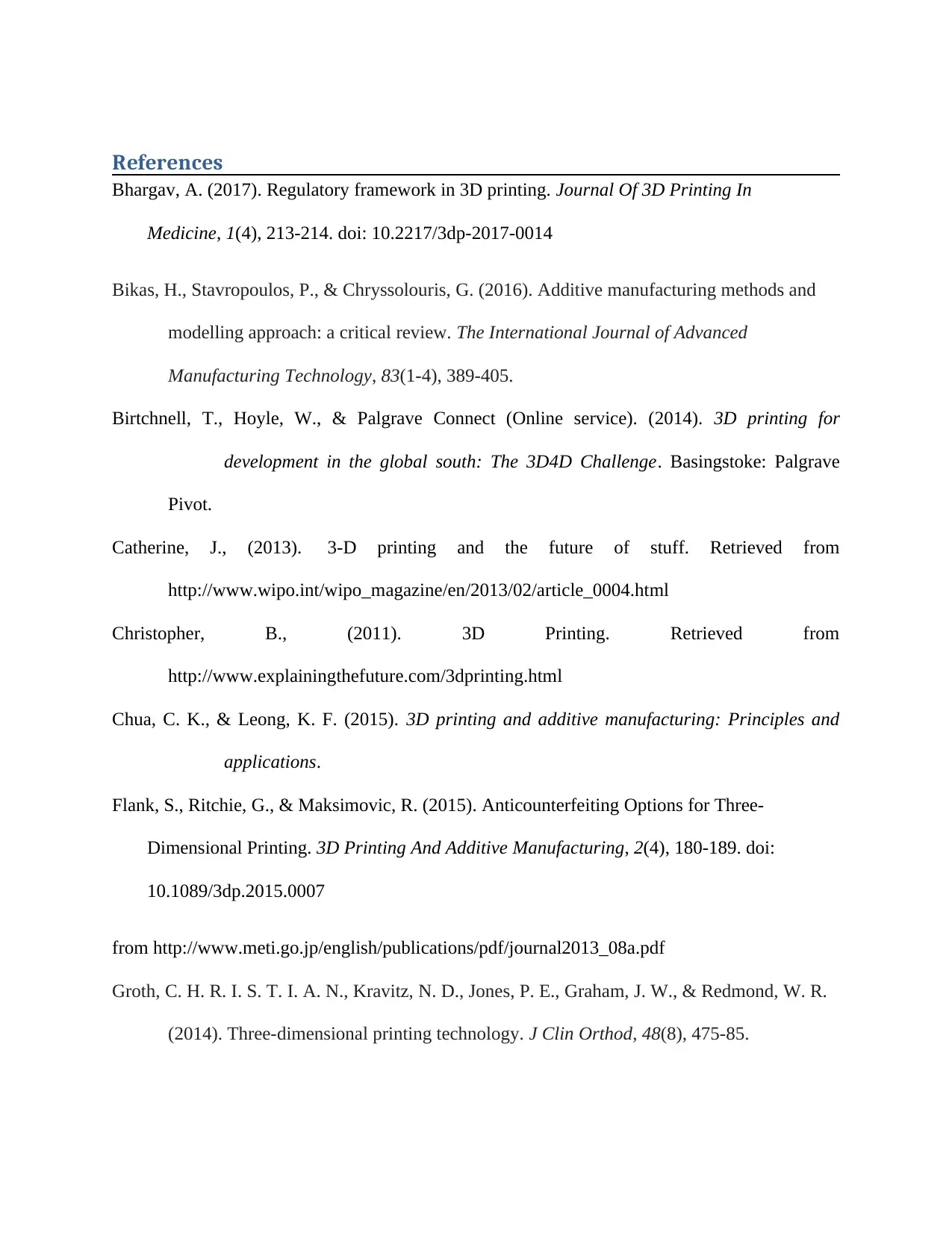
References
Bhargav, A. (2017). Regulatory framework in 3D printing. Journal Of 3D Printing In
Medicine, 1(4), 213-214. doi: 10.2217/3dp-2017-0014
Bikas, H., Stavropoulos, P., & Chryssolouris, G. (2016). Additive manufacturing methods and
modelling approach: a critical review. The International Journal of Advanced
Manufacturing Technology, 83(1-4), 389-405.
Birtchnell, T., Hoyle, W., & Palgrave Connect (Online service). (2014). 3D printing for
development in the global south: The 3D4D Challenge. Basingstoke: Palgrave
Pivot.
Catherine, J., (2013). 3-D printing and the future of stuff. Retrieved from
http://www.wipo.int/wipo_magazine/en/2013/02/article_0004.html
Christopher, B., (2011). 3D Printing. Retrieved from
http://www.explainingthefuture.com/3dprinting.html
Chua, C. K., & Leong, K. F. (2015). 3D printing and additive manufacturing: Principles and
applications.
Flank, S., Ritchie, G., & Maksimovic, R. (2015). Anticounterfeiting Options for Three-
Dimensional Printing. 3D Printing And Additive Manufacturing, 2(4), 180-189. doi:
10.1089/3dp.2015.0007
from http://www.meti.go.jp/english/publications/pdf/journal2013_08a.pdf
Groth, C. H. R. I. S. T. I. A. N., Kravitz, N. D., Jones, P. E., Graham, J. W., & Redmond, W. R.
(2014). Three-dimensional printing technology. J Clin Orthod, 48(8), 475-85.
Bhargav, A. (2017). Regulatory framework in 3D printing. Journal Of 3D Printing In
Medicine, 1(4), 213-214. doi: 10.2217/3dp-2017-0014
Bikas, H., Stavropoulos, P., & Chryssolouris, G. (2016). Additive manufacturing methods and
modelling approach: a critical review. The International Journal of Advanced
Manufacturing Technology, 83(1-4), 389-405.
Birtchnell, T., Hoyle, W., & Palgrave Connect (Online service). (2014). 3D printing for
development in the global south: The 3D4D Challenge. Basingstoke: Palgrave
Pivot.
Catherine, J., (2013). 3-D printing and the future of stuff. Retrieved from
http://www.wipo.int/wipo_magazine/en/2013/02/article_0004.html
Christopher, B., (2011). 3D Printing. Retrieved from
http://www.explainingthefuture.com/3dprinting.html
Chua, C. K., & Leong, K. F. (2015). 3D printing and additive manufacturing: Principles and
applications.
Flank, S., Ritchie, G., & Maksimovic, R. (2015). Anticounterfeiting Options for Three-
Dimensional Printing. 3D Printing And Additive Manufacturing, 2(4), 180-189. doi:
10.1089/3dp.2015.0007
from http://www.meti.go.jp/english/publications/pdf/journal2013_08a.pdf
Groth, C. H. R. I. S. T. I. A. N., Kravitz, N. D., Jones, P. E., Graham, J. W., & Redmond, W. R.
(2014). Three-dimensional printing technology. J Clin Orthod, 48(8), 475-85.
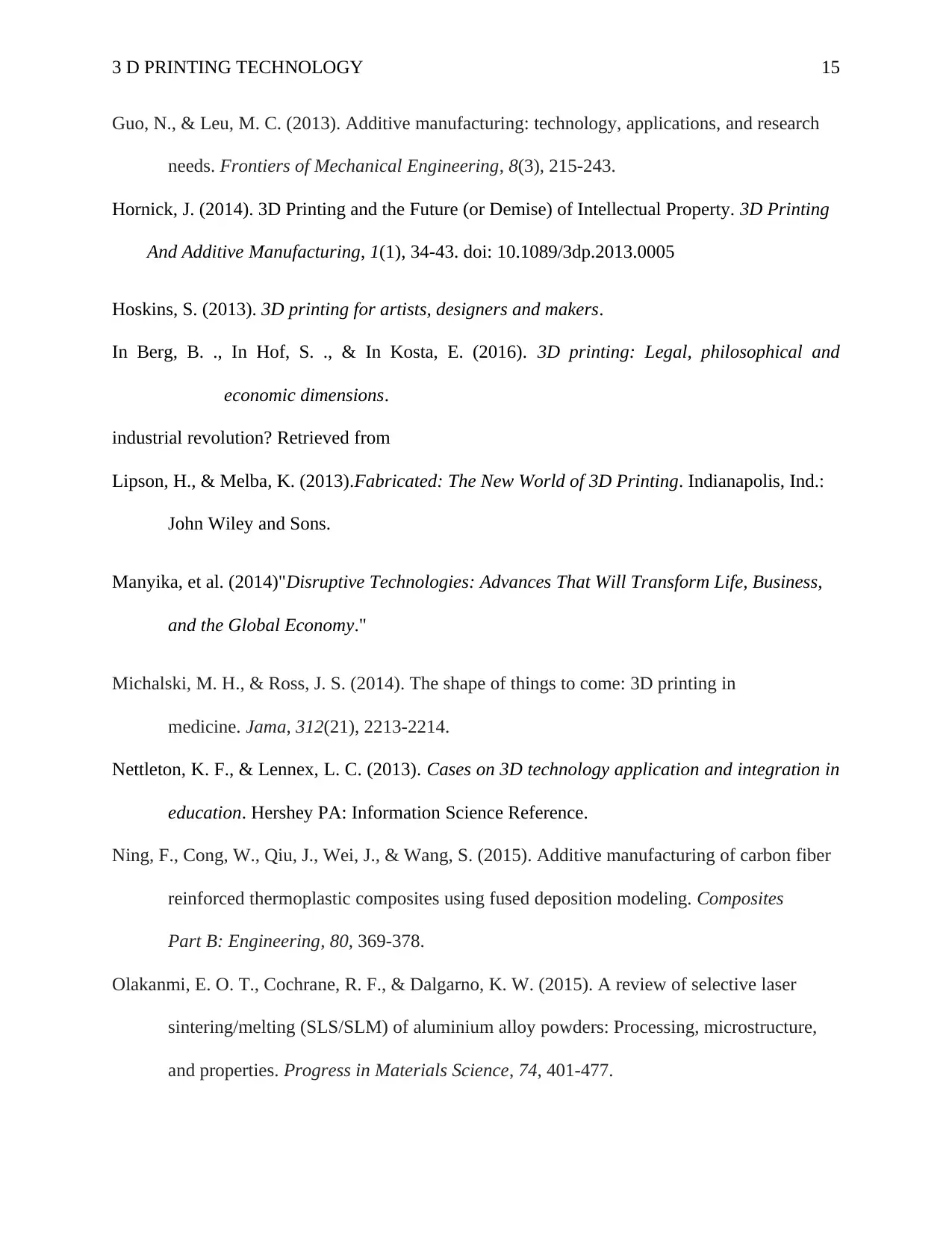
3 D PRINTING TECHNOLOGY 15
Guo, N., & Leu, M. C. (2013). Additive manufacturing: technology, applications, and research
needs. Frontiers of Mechanical Engineering, 8(3), 215-243.
Hornick, J. (2014). 3D Printing and the Future (or Demise) of Intellectual Property. 3D Printing
And Additive Manufacturing, 1(1), 34-43. doi: 10.1089/3dp.2013.0005
Hoskins, S. (2013). 3D printing for artists, designers and makers.
In Berg, B. ., In Hof, S. ., & In Kosta, E. (2016). 3D printing: Legal, philosophical and
economic dimensions.
industrial revolution? Retrieved from
Lipson, H., & Melba, K. (2013).Fabricated: The New World of 3D Printing. Indianapolis, Ind.:
John Wiley and Sons.
Manyika, et al. (2014)"Disruptive Technologies: Advances That Will Transform Life, Business,
and the Global Economy."
Michalski, M. H., & Ross, J. S. (2014). The shape of things to come: 3D printing in
medicine. Jama, 312(21), 2213-2214.
Nettleton, K. F., & Lennex, L. C. (2013). Cases on 3D technology application and integration in
education. Hershey PA: Information Science Reference.
Ning, F., Cong, W., Qiu, J., Wei, J., & Wang, S. (2015). Additive manufacturing of carbon fiber
reinforced thermoplastic composites using fused deposition modeling. Composites
Part B: Engineering, 80, 369-378.
Olakanmi, E. O. T., Cochrane, R. F., & Dalgarno, K. W. (2015). A review of selective laser
sintering/melting (SLS/SLM) of aluminium alloy powders: Processing, microstructure,
and properties. Progress in Materials Science, 74, 401-477.
Guo, N., & Leu, M. C. (2013). Additive manufacturing: technology, applications, and research
needs. Frontiers of Mechanical Engineering, 8(3), 215-243.
Hornick, J. (2014). 3D Printing and the Future (or Demise) of Intellectual Property. 3D Printing
And Additive Manufacturing, 1(1), 34-43. doi: 10.1089/3dp.2013.0005
Hoskins, S. (2013). 3D printing for artists, designers and makers.
In Berg, B. ., In Hof, S. ., & In Kosta, E. (2016). 3D printing: Legal, philosophical and
economic dimensions.
industrial revolution? Retrieved from
Lipson, H., & Melba, K. (2013).Fabricated: The New World of 3D Printing. Indianapolis, Ind.:
John Wiley and Sons.
Manyika, et al. (2014)"Disruptive Technologies: Advances That Will Transform Life, Business,
and the Global Economy."
Michalski, M. H., & Ross, J. S. (2014). The shape of things to come: 3D printing in
medicine. Jama, 312(21), 2213-2214.
Nettleton, K. F., & Lennex, L. C. (2013). Cases on 3D technology application and integration in
education. Hershey PA: Information Science Reference.
Ning, F., Cong, W., Qiu, J., Wei, J., & Wang, S. (2015). Additive manufacturing of carbon fiber
reinforced thermoplastic composites using fused deposition modeling. Composites
Part B: Engineering, 80, 369-378.
Olakanmi, E. O. T., Cochrane, R. F., & Dalgarno, K. W. (2015). A review of selective laser
sintering/melting (SLS/SLM) of aluminium alloy powders: Processing, microstructure,
and properties. Progress in Materials Science, 74, 401-477.
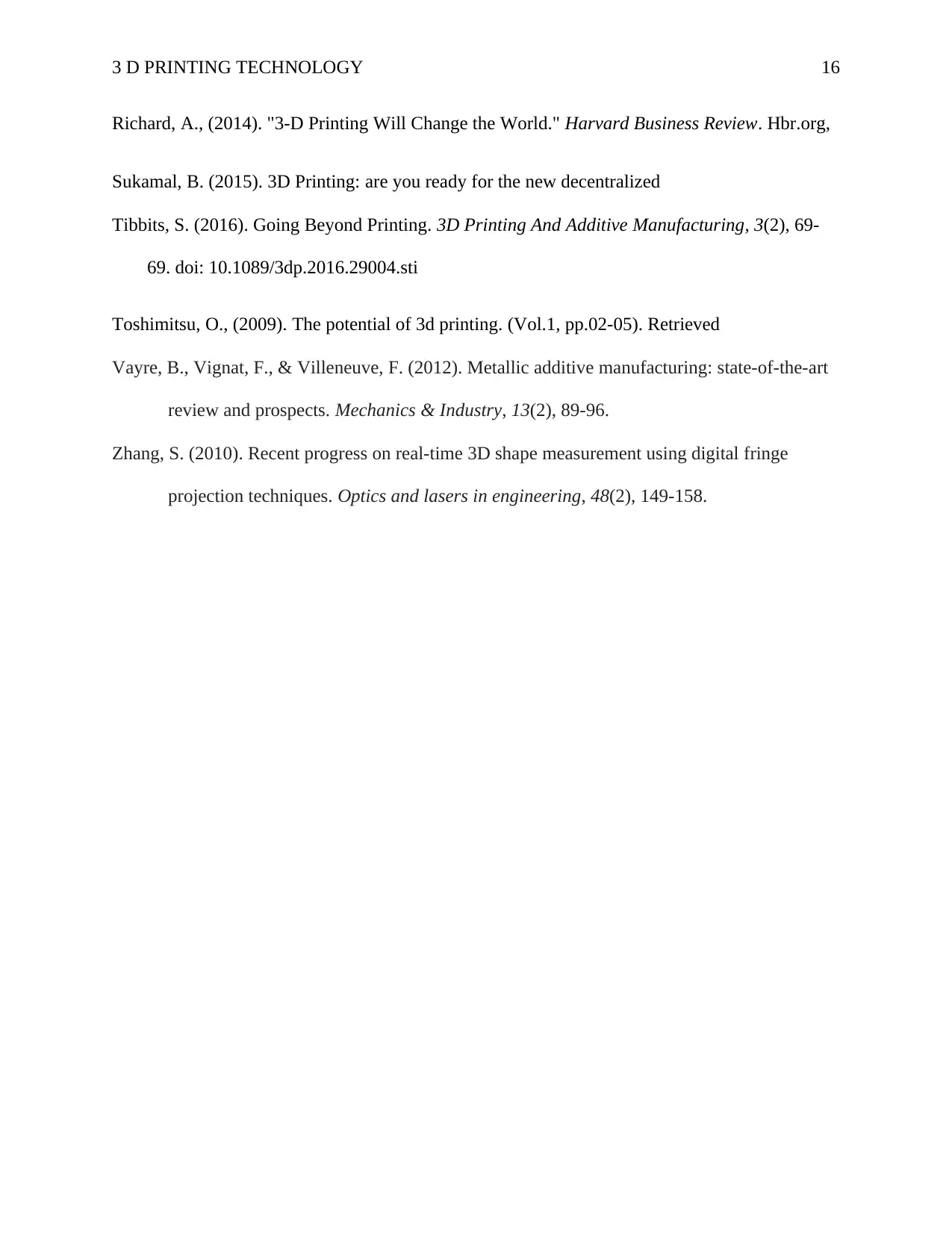
3 D PRINTING TECHNOLOGY 16
Richard, A., (2014). "3-D Printing Will Change the World." Harvard Business Review. Hbr.org,
Sukamal, B. (2015). 3D Printing: are you ready for the new decentralized
Tibbits, S. (2016). Going Beyond Printing. 3D Printing And Additive Manufacturing, 3(2), 69-
69. doi: 10.1089/3dp.2016.29004.sti
Toshimitsu, O., (2009). The potential of 3d printing. (Vol.1, pp.02-05). Retrieved
Vayre, B., Vignat, F., & Villeneuve, F. (2012). Metallic additive manufacturing: state-of-the-art
review and prospects. Mechanics & Industry, 13(2), 89-96.
Zhang, S. (2010). Recent progress on real-time 3D shape measurement using digital fringe
projection techniques. Optics and lasers in engineering, 48(2), 149-158.
Richard, A., (2014). "3-D Printing Will Change the World." Harvard Business Review. Hbr.org,
Sukamal, B. (2015). 3D Printing: are you ready for the new decentralized
Tibbits, S. (2016). Going Beyond Printing. 3D Printing And Additive Manufacturing, 3(2), 69-
69. doi: 10.1089/3dp.2016.29004.sti
Toshimitsu, O., (2009). The potential of 3d printing. (Vol.1, pp.02-05). Retrieved
Vayre, B., Vignat, F., & Villeneuve, F. (2012). Metallic additive manufacturing: state-of-the-art
review and prospects. Mechanics & Industry, 13(2), 89-96.
Zhang, S. (2010). Recent progress on real-time 3D shape measurement using digital fringe
projection techniques. Optics and lasers in engineering, 48(2), 149-158.
1 out of 16
Related Documents
Your All-in-One AI-Powered Toolkit for Academic Success.
+13062052269
info@desklib.com
Available 24*7 on WhatsApp / Email
![[object Object]](/_next/static/media/star-bottom.7253800d.svg)
Unlock your academic potential
© 2024 | Zucol Services PVT LTD | All rights reserved.




